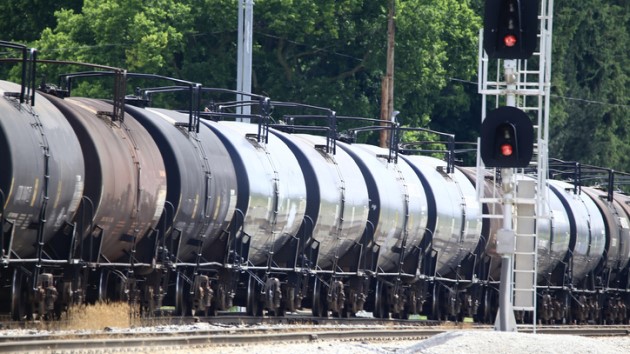(OHIO) — ABC News has obtained new footage, via a public records request, of evacuation efforts on the night when a Norfolk Southern-operated train carrying toxic chemicals derailed in East Palestine, Ohio, earlier this year.
The footage, released first to ABC News on Thursday, shows roughly 30 minutes of body camera as Ohio State Highway Patrol went from door to door on the night of Feb. 3, in the immediate aftermath of the fiery crash, and evacuation efforts several days later — when the risk of a major explosion at the site amped up authorities’ request to get people out of the area.
According to the first clip’s body camera timestamp, it’s about 10 p.m. on the night of the derailment.
Going up and down the quiet residential streets, a patrolman calmly asks people to evacuate — informing them of what had happened, if they didn’t already know, the concerns over toxic fumes in the area, and the worry of a possible explosion. His feet crunch on the frozen ground as he goes from house to house.
As he walks, his body camera catches glimpses of smoke billowing in the background.
The evacuation zone was first a 1-mile radius around the derailment site. It was later expanded to a 2-mile radius when authorities conducted a controlled burn at the site.
“Hello, we’ve gotta get everybody to evacuate ’cause of that train fire, they’re worried everything else is going to blow,” the patrolman says to one resident.
Residents seem dismayed at having to leave their homes. Some are unsure of where they can go.
“One mile?” one man on the street says, incredulous at the evacuation radius.
“Yep, they think there’s hazmat involved,” the patrolman says.
“Oh, I’m sure,” the man responds.
“We don’t know, something might blow, or toxic fumes… so we just need everyone out, okay?” the patrolman says.
Standing on her front porch, another resident asks, “where’s the train at?”
“It’s – I mean if you look right here, you can see the orange in the sky from the flames,” the patrolman responds. “It’s blocking the main crossing there in town, too. It derailed back there and the whole thing stopped up there, alrighty?” he says.
The resident asks how long it’ll take, and if the evacuation is optional.
“We don’t know how bad the hazmat is, and whatnot… it shouldn’t be, hopefully not too long, but at least want, you know, the toxic fumes and whatnot, want to make sure everyone’s out of here, okay?”
He tells people if they need somewhere warm to go, they can go to the high school.
Sirens can be heard intermittently blaring in the background.
About halfway through the footage, the body cam cuts to several days later — with a timestamp of Feb. 6 around 3:45 a.m.
It was on the evening of Feb. 5 that a “drastic temperature change” had occurred in one of the rail cars, threatening a “catastrophic tanker failure” and the potential for a “major explosion,” authorities said — issuing a new, urgent warning to East Palestinians living within a mile of the derailment.
On this second body camera angle, a few days after the derailment, there is no answer at many of the doors the patrolman knocks on.
Over his radio, others can be heard saying they too have had “no contact” at various addresses they’ve tried.
One resident, who does answer his door, answers without any urgency — but with some skepticism.
“I’m questioning the arbitrary mile,” he says. “There’s quite a buffer zone between me and that… and it’s magically safe two hundred yards down the road. I would prefer to just shelter in place in case something does come up.”
He seems more interested in the troopers’ outfits — asking several follow-up questions about their hats — but says he would “prefer to shelter in place,” and that “there’s only two of us in here” and if something did change they could get out “fairly quickly.” He elects not to evacuate.
The derailment in East Palestine rocked the small Ohio town and its emergency response, and kicked off a long, slow effort as contaminated soil and water were hauled out from the site.
The train, operated by Norfolk Southern, had been carrying chemicals and combustible materials, including the toxic, highly volatile gas vinyl chloride, which when burned can pose serious health risks. Vinyl chloride burning can create dioxins which is carcinogenic, according to the Environmental Protection Agency.
But fearful that some of the tanker cars carrying those hazardous materials could explode, authorities expanded the evacuation zone and carried out a controlled release and burn of the chemicals.
A controlled burn neutralized the threat of an explosion, but it also fomented already brewing concerns about the long-term health effects the derailment and the fire could have on residents’ health and the environment. Though the EPA has said they are “committed to protecting the health and safety of the East Palestine, Ohio community” and Ohio’s governor has said “drinking water sampling results from the East Palestine Municipal Water System show no indication of contaminants associated with the derailment,” residents’ concerns have lingered.
Norfolk Southern has sworn they would “make it right,” and pledged millions of dollars in support to impacted communities in Ohio and Pennsylvania, including what they say is nearly $4.3 million as part of a “long-term commitment to protect East Palestine drinking water,” along with the legally binding order from EPA to conduct all cleanup actions associated with the East Palestine derailment.
Copyright © 2023, ABC Audio. All rights reserved.












